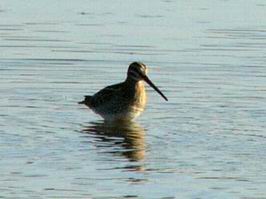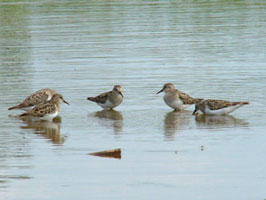Snipe
(Gallinago gallinago)

The snipe is hardly larger than the starling in size. It has a longest beak, compared to the length of the whole body. Its bottom is white; the wings from below are white, from above — with a white strip on the back edge (it can be seen in flight). The back is reddish-brown with fine painting of dark and light flashes.
The snipe is most active at dawns.
Snipes form new couples every year. If there are too many females, there are polygamous marriages.
From April till July males make courtship display flights above their sites. First, a male flies high in the sky; then it falls almost vertically downwards — and again abruptly flies up. When falling, it makes a strange sound resembling bleating. This sound originates from vibration of the tail feathers and is audible on the distance up to several hundreds meters.
The clutch is incubated by the female alone.
Snipes eat by sticking beaks in silt and groping the food by the tip of the beak on the depth of up to 6 cm and more. Then the bird opens the tip of the beak and grasps a worm, roof of a plant, etc. Thus snipes can swallow food, without taking the beak out from the silt.
Little Stint
(Calidris minuta)
This bird is noticeably less than the starling, with a short straight beak. The back side of its body in summer is reddish; the sides of the neck and breast are brownish; the belly is white. On the back, there is a thin white painting in the form of letter "V". The legs are black. In autumn, it is colored a little lightly; the back is without reddish color; the sides of the neck are grey.
Little stints winter in the tropics of Africa and Asia.
Prior to beginning of July, males perform courtship display flights with singing. In such a flight, they hold the wings higher than usual. Or they sing a song from a branch of a tree.
The nest of the little stint is usually located on the ground — on a dry high place near water. Sometimes, a nest is lined with several leaflets, but more often it is simply a pit in the ground.
Dunlin (Calidrid)
(Calidris alpina)
It is a little less than the starling, with a rather long beak, which is slightly bent downwards; the back side of the body is brown with dark flashes; the belly is light-grey with big black stain. In autumn, its upper part is grey-smoky; the stain on the belly becomes grey.
The dunlin almost all the daytime minces at shallowness on silt or sand, probing them with their beaks.
They can swim.
Dunlins have a rest usually at midday; at that, they stand in groups at the line of a surf, the heads turned to wind.



-5.jpg)